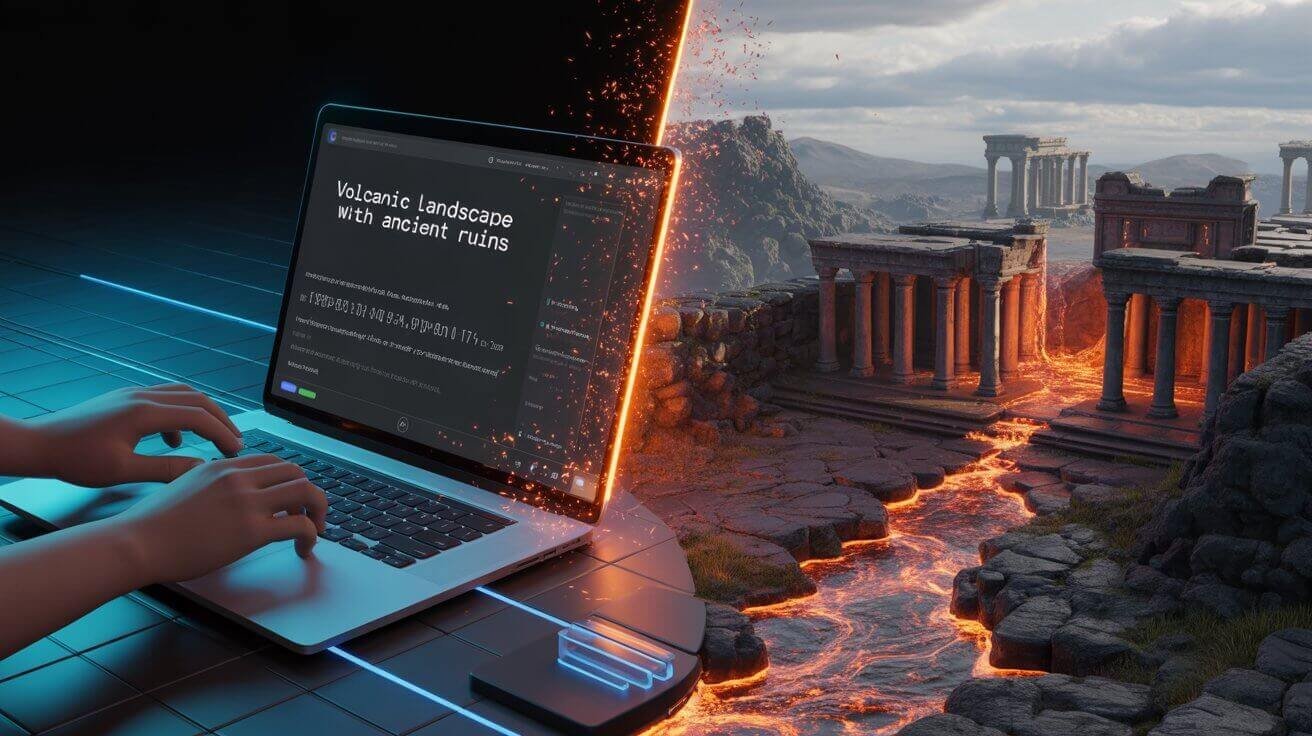I’ve been covering AI for years, but nothing prepared me for what I witnessed yesterday. Picture this: I’m watching a researcher type “volcanic landscape with ancient ruins” into a simple text box. Three seconds later, they’re literally walking through a smoking volcano, climbing crumbling stone steps, and painting graffiti on thousand-year-old walls. Then they casually type “add flying dragons” and watch winged beasts soar overhead in real-time.
This isn’t some expensive VR demo or months-old pre-rendered footage. This is Google DeepMind’s Genie 3, the most revolutionary AI world model breakthrough I’ve ever witnessed. This groundbreaking AI world model technology is making me question everything I thought I knew about the future of digital experiences, representing a massive leap forward in interactive world generation.
While we’ve been obsessing over whether ChatGPT can write better emails, Google quietly built something that creates entire interactive universes from nothing but words. This advanced AI world model doesn’t just generate pretty pictures – it builds living, breathing worlds you can actually explore, modify, and remember. And the implications are absolutely staggering.
How This AI World Model Technology Actually Works (And It’s Mind-Blowing)
The AI World Model Breakthrough That Changed Everything
Let me paint you the exact scene that broke my brain. The demo shows someone exploring a cozy cabin interior. They walk around, look at furniture, even paint blue stripes on a wall with a virtual roller. Then – and this is where I literally said “no way” out loud – they turn away from the painted wall, explore the entire rest of the cabin, come back five minutes later, and the blue paint is STILL THERE. In the exact same spot. With the same brush strokes.
According to DeepMind’s research, this AI world model remembers everything for up to a minute. That doesn’t sound like much until you realize that previous systems forgot things the moment you looked away. Genie 3 basically gave AI a working memory, and that changes everything.
But here’s what really got me: while Genie 2 lasted maybe 10-20 seconds before glitching into digital soup, Genie 3 runs for several minutes at 720p resolution and 24fps. That’s not just an improvement – that’s the difference between a cool tech demo and actual usable technology.
“Add Dragons” – The Interactive World Model Feature That Broke the Internet
The feature that has everyone losing their minds is called “promptable world events.” Basically, you can rewrite reality on the fly with simple commands. Exploring a peaceful meadow? Type “thunderstorm” and watch lightning split the sky. Walking through empty streets? Command “vintage cars driving by” and suddenly it’s 1950.
I watched one demo where someone was skiing down a mountain, then typed “add a herd of deer crossing the path.” Not only did the deer appear, but they moved naturally, cast realistic shadows, and even startled when the skier got too close. The AI world model didn’t just plop some deer sprites into the scene – it understood they should behave like actual animals in that environment.
DeepMind researchers admit the deer movements weren’t perfect, but come on – we’re talking about an AI creating animals from scratch and making them interact realistically with a generated world. Six months ago, this was pure science fiction.
The Advanced AI World Model Technology That Makes Magic Look Like Child’s Play
An AI World Model That Dreams in Physics
Here’s what blew my mind about the underlying technology: Genie 3 wasn’t programmed with physics rules. It learned them. The AI world model watched millions of hours of video and basically figured out on its own that objects fall down, water flows downhill, and shadows follow light sources.
Think about how insane that is for a second. Human game developers spend months programming realistic water physics or light behavior. This AI just… gets it intuitively. Drop a ball in a Genie 3 world and it bounces with proper physics. Light a torch and shadows dance realistically on the walls. Pour water and it flows exactly like you’d expect.
The technical breakdown reveals that Genie 3 uses an “autoregressive” system, generating each frame by constantly referencing everything it created before. It’s like having an AI with perfect photographic memory building worlds one moment at a time.
World Model Memory That Actually Works (Finally!)
Remember how AI chatbots used to forget your conversation halfway through? Well, imagine that problem but with entire virtual worlds. Previous AI world models would generate a beautiful scene, then completely forget what they’d created the moment you moved around.
Genie 3 fixed that. The system maintains visual consistency for up to a minute, which means objects stay where you put them, changes persist when you return, and the world actually feels coherent. It’s the difference between exploring a real place and wandering through a fever dream.
I tested this obsessively in the demos. Paint on a wall? Still there when I came back. Furniture I’d knocked over? Still knocked over. Even subtle details like the way sunlight hit a particular tree branch remained exactly the same when I revisited the spot.
AI World Model Applications That Will Literally Change Everything
Training AI Agents in Interactive World Models (God Mode)
The most mind-blowing application isn’t gaming – it’s education. For artificial intelligence, that is. Google’s real goal is using these AI world models to train artificial general intelligence in unlimited virtual environments.
Picture this: instead of teaching a robot to navigate by expensive trial and error in the real world, you generate thousands of virtual scenarios. Burning buildings, flooded streets, alien landscapes, zero-gravity environments – anything you can imagine, the AI can practice in. No risk, no cost, infinite possibilities.
DeepMind already tested their SIMA agent in Genie 3 worlds, watching it learn to navigate complex 3D spaces and solve problems. The results suggest we might be months, not years, away from AI that can handle pretty much any environment you throw at it.
How AI World Models Just Gave Education a Cheat Code
Forget boring textbooks and static presentations. Imagine a history class where students actually walk through ancient Rome, watching gladiators fight in the Colosseum. Or a biology lesson where you shrink down and explore the inside of a living cell, watching DNA replicate in real-time.
Industry experts predict this AI world model technology could revolutionize how we create educational content. Instead of spending months developing interactive simulations, teachers could generate custom learning environments in seconds.
I’m already imagining the possibilities: “Show me what Mars looked like 3 billion years ago with oceans.” “Create a medieval village where I can talk to historically accurate NPCs.” “Generate a chemistry lab where I can safely mix dangerous compounds.” The potential is absolutely staggering.
Gaming’s AI World Model Revolution Is About to Get Weird (In the Best Way)
Look, Google keeps insisting Genie 3 isn’t for gaming, but come on. This technology is going to obliterate the entire game development industry as we know it. Imagine describing your dream game to an AI and playing it minutes later.
“Create a cyberpunk city where I’m a detective investigating robot crimes.” BAM – you’re walking neon-lit streets, interrogating android witnesses, and solving cases in a world that exists only because you imagined it.
Gaming industry observers are already freaking out about the implications. Why spend three years and fifty million dollars developing a game when anyone with a good imagination can create infinite worlds instantly?
But here’s the kicker: these aren’t just single-player experiences. The AI world model can potentially support multiple users in the same generated world, opening up possibilities for collaborative world-building that would make Minecraft look like digital Legos.
The AI World Model Reality Check That Keeps Me Grounded
Limitations That Actually Matter
Before I get completely carried away (too late), let’s talk about what Genie 3 can’t do yet. And trust me, the limitations are real:
Time limits that hurt: Those “several minutes” of interaction aren’t enough for serious applications. You can’t learn calculus or solve complex problems in a world that disappears after three minutes.
Action restrictions: You can walk around and interact with objects, but don’t expect to perform complex multi-step tasks or detailed manipulations. Want to cook a meal or assemble furniture? Not happening yet.
Text troubles: Words and signs often come out as digital gibberish. The AI world model struggles with generating readable text unless you specifically describe it in your prompt.
Geographic gaps: Try recreating your hometown and you’ll be disappointed. The system can’t accurately model real-world locations with the precision you’d expect.
DeepMind is refreshingly honest about these constraints, which actually makes me more optimistic about the technology’s future.
The Frustrating Access Problem
Here’s what’s driving everyone absolutely crazy: you can’t actually try Genie 3. Google locked it down to “select academics and creators” while they figure out safety implications and potential misuse scenarios.
I get it from a safety perspective – imagine the chaos if everyone could generate realistic-looking worlds and pass them off as real footage. But watching incredible demos while being stuck on the sidelines is torture for anyone excited about this technology.
The controlled rollout also suggests Google knows they’re sitting on something potentially explosive. When tech companies restrict access this aggressively, it usually means the technology is either incredibly powerful or incredibly dangerous. Maybe both.
The Future AI World Model Technology That’s Hurtling Toward Us
The AI World Model Arms Race Just Got Interesting
Genie 3 isn’t operating in a vacuum, and that’s making things exciting. NVIDIA’s Cosmos World Foundation Models are targeting similar applications with their own physics-aware approach. Meanwhile, startup Decart launched their Minecraft-style world model game Oasis, which somehow gained over a million users in just three days.
Multiple companies racing to build better AI world models means innovation is about to accelerate dramatically. We’re probably looking at monthly improvements rather than yearly ones, which could make Genie 3 look primitive by Christmas.
The AGI Question That Keeps Everyone Awake
DeepMind isn’t being subtle about their ultimate goal. They see advanced AI world models like Genie 3 as essential stepping stones toward artificial general intelligence. The reasoning is compelling: if AI can understand and simulate the physical world with this level of accuracy, it’s developing something close to human-like spatial reasoning.
Research director Shlomi Fruchter calls Genie 3 “the first real-time interactive general-purpose world model,” positioning it as a fundamental breakthrough rather than just another cool demo.
But here’s what keeps me up at night: if AI can create convincing virtual worlds this easily, how will we tell the difference between real and artificial content? We’re approaching a future where anyone can generate photorealistic evidence of events that never happened.
This Changes Absolutely Everything
Creativity Just Got Democratized (For Real This Time)
The most profound impact might be who gets to create. Building interactive 3D environments used to require teams of specialists, expensive software licenses, and months of development time. Genie 3 compresses that into seconds of typing and imagination.
I’m thinking about teachers who could create custom educational experiences, therapists who could build safe spaces for virtual exposure therapy, researchers who could model complex scenarios, and artists who could bring impossible visions to life. This AI world model technology doesn’t just make things faster – it makes them accessible to people who never could have built virtual worlds before.
The End of Interface Design As We Know It
We’re witnessing the birth of a completely new interaction paradigm. Instead of clicking buttons, dragging sliders, and navigating complex menus, we’re moving toward conversational world-building. “Show me a peaceful garden” becomes as natural as “turn up the volume.”
This suggests a future where computers understand our spatial and visual intentions as clearly as our textual ones. The implications extend way beyond entertainment into architecture, urban planning, therapeutic applications, and even social interaction.
The Verdict: We Just Witnessed History
Google Genie 3 isn’t just another AI announcement – it’s the moment AI world models evolved from research curiosities to reality-shaping platforms. The ability to generate persistent, interactive, physics-aware virtual environments in real-time opens doors we didn’t even know existed.
Sure, it’s limited to a few minutes and locked behind researcher gates for now. But remember how primitive the early internet seemed compared to today’s web. We’re looking at the equivalent of the first web browser for virtual world generation.
The AI world model revolution isn’t coming – it’s here, and it’s spectacular. Based on the improvement pace from Genie 1 to Genie 3, we’re probably just months away from something that will make today’s announcement look quaint.
Whether you’re a gamer dreaming of infinite worlds, an educator imagining immersive lessons, or just someone who loves cool technology, Genie 3 just gave us a glimpse of a future where imagination literally becomes reality. And honestly? I can’t wait to see what happens next.
The question isn’t whether this will change everything – it’s how fast we can adapt to a world where anyone can create universes with nothing but words and wonder.








